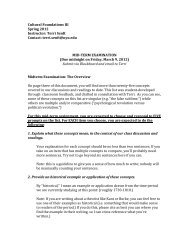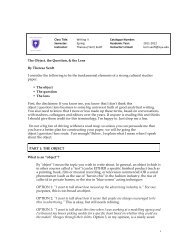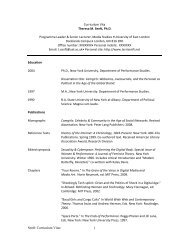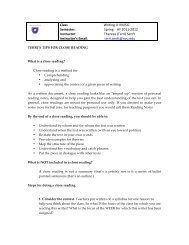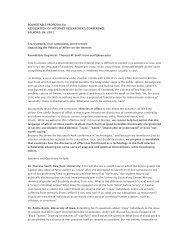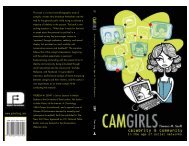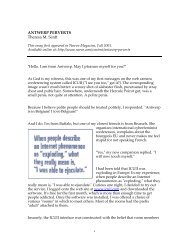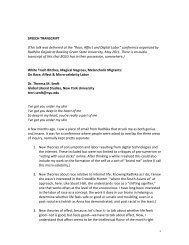New York University Gallatin School of Individualized ... - Terri Senft
New York University Gallatin School of Individualized ... - Terri Senft
New York University Gallatin School of Individualized ... - Terri Senft
You also want an ePaper? Increase the reach of your titles
YUMPU automatically turns print PDFs into web optimized ePapers that Google loves.
FINDING A COLLOQUIUM TOPIC FROM THE “INSIDE OUT”<br />
Tactic 1. Consider a problem within a theme<br />
A theme is a category, <strong>of</strong>ten broadly construed (as, for example, democracy, race, gender, sexual<br />
identity or class) and can be applied to a number <strong>of</strong> different historical periods or areas <strong>of</strong> the<br />
world. A theme may be labeled a problem if it is expressed as a question. Examples <strong>of</strong> appropriate<br />
colloquium questions derived from themes include:<br />
• What does “representation” mean, artistically and politically?<br />
• How did rationality and scientific thought become the dominant mode <strong>of</strong> thought in<br />
Western culture?<br />
• How have social trends been determined through history?<br />
• What does it mean to speak <strong>of</strong> “artificial intelligence”?<br />
Tactic 2. Find a timeless question within a specific period <strong>of</strong> interest.<br />
Many students find themselves drawn to a particular time in human history, such as the Middle<br />
Ages, the post-WWII period, or the Internet age. For a colloquium, a student might want to<br />
investigate a certain timeless question that emanates from their study <strong>of</strong> a particular period, such<br />
as:<br />
• How did the Industrial Revolution forever change what is meant by revolution?<br />
• What can Internet theorists <strong>of</strong> “social networks” learn from the architects <strong>of</strong> Rome, who<br />
designed some <strong>of</strong> the first road and plumbing systems?<br />
• What’s the connection between postmodernism and a renewed interest in Greek sophists?<br />
Tactic 3: Find a boundless question within a bounded area <strong>of</strong> interest.<br />
A student who studies a particular bounded area (bounded by geography or time, e.g. pre-<br />
Columbian South America or Imperial China in the 19 th century) may want to formulate a boundless<br />
question for their colloquium.<br />
• What are the artistic legacies <strong>of</strong> Islam (using Saudi Arabia, Malaysia, and <strong>New</strong> <strong>York</strong>)<br />
• Eastern European arts, bureaucracy and the state<br />
• Colonialism and the arts: India and China<br />
Tactic 4: Expand upon a legacy.<br />
Sometimes, a student with a narrow-sounding phenomenon (e.g., the Vietnam War, Darwin) but<br />
expands outward to look at related and contextual ideas and problems. Examples:<br />
• Darwin’s legacy: from biological to social theories <strong>of</strong> evolution<br />
• Pulitzer and other prizes: the history <strong>of</strong> market forces and publishing<br />
• Beyond Woodstock: mass organizing, the arts, and the future<br />
5 <strong>of</strong> 20



